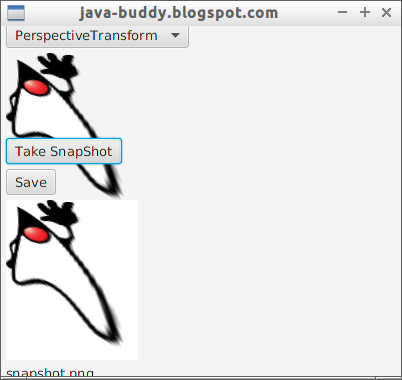This post show various
Effect applied on ImageView.

package javafximage;
import java.awt.image.RenderedImage;
import java.io.File;
import java.io.IOException;
import java.util.logging.Level;
import java.util.logging.Logger;
import javafx.application.Application;
import javafx.beans.value.ObservableValue;
import javafx.collections.FXCollections;
import javafx.embed.swing.SwingFXUtils;
import javafx.event.ActionEvent;
import javafx.geometry.Insets;
import javafx.scene.Node;
import javafx.scene.Scene;
import javafx.scene.SnapshotParameters;
import javafx.scene.control.Button;
import javafx.scene.control.ChoiceBox;
import javafx.scene.control.Label;
import javafx.scene.effect.Blend;
import javafx.scene.effect.BlendMode;
import javafx.scene.effect.Bloom;
import javafx.scene.effect.BlurType;
import javafx.scene.effect.BoxBlur;
import javafx.scene.effect.ColorAdjust;
import javafx.scene.effect.ColorInput;
import javafx.scene.effect.DisplacementMap;
import javafx.scene.effect.DropShadow;
import javafx.scene.effect.Effect;
import javafx.scene.effect.FloatMap;
import javafx.scene.effect.GaussianBlur;
import javafx.scene.effect.Glow;
import javafx.scene.effect.ImageInput;
import javafx.scene.effect.InnerShadow;
import javafx.scene.effect.Light;
import javafx.scene.effect.Lighting;
import javafx.scene.effect.MotionBlur;
import javafx.scene.effect.PerspectiveTransform;
import javafx.scene.effect.Reflection;
import javafx.scene.effect.SepiaTone;
import javafx.scene.effect.Shadow;
import javafx.scene.image.Image;
import javafx.scene.image.ImageView;
import javafx.scene.image.WritableImage;
import javafx.scene.layout.StackPane;
import javafx.scene.layout.VBox;
import javafx.scene.paint.Color;
import javafx.stage.Stage;
import javax.imageio.ImageIO;
/**
*
* @web http://java-buddy.blogspot.com
*/
public class JavaFXImage extends Application {
@Override
public void start(Stage primaryStage) {
Image image = new Image("http://goo.gl/kYEQl");
ImageView imageView = new ImageView();
imageView.setImage(image);
Image secondImage = new Image("http://goo.gl/Z6Qiw0");
int imageWidth = (int) image.getWidth();
int imageHeight = (int) image.getHeight();
//Blend effect
Blend blend = new Blend();
blend.setMode(BlendMode.COLOR_BURN);
ColorInput blendColorInput = new ColorInput();
blendColorInput.setPaint(Color.STEELBLUE);
blendColorInput.setX(0);
blendColorInput.setY(0);
blendColorInput.setWidth(imageWidth);
blendColorInput.setHeight(imageHeight);
blend.setTopInput(blendColorInput);
//Bloom effect
Bloom bloom = new Bloom(0.1);
//BoxBlur effect
BoxBlur boxBlur = new BoxBlur();
boxBlur.setWidth(3);
boxBlur.setHeight(3);
boxBlur.setIterations(3);
//ColorAdjust effect
ColorAdjust colorAdjust = new ColorAdjust();
colorAdjust.setContrast(0.1);
colorAdjust.setHue(-0.05);
colorAdjust.setBrightness(0.1);
colorAdjust.setSaturation(0.2);
//ColorInput effect
ColorInput colorInput;
colorInput = new ColorInput(0, 0,
imageWidth, imageHeight, Color.STEELBLUE);
//DisplacementMap effect
FloatMap floatMap = new FloatMap();
floatMap.setWidth(imageWidth);
floatMap.setHeight(imageHeight);
for (int i = 0; i < imageWidth; i++) {
double v = (Math.sin(i / 20.0 * Math.PI) - 0.5) / 40.0;
for (int j = 0; j < imageHeight; j++) {
floatMap.setSamples(i, j, 0.0f, (float) v);
}
}
DisplacementMap displacementMap = new DisplacementMap();
displacementMap.setMapData(floatMap);
//DropShadow effect
DropShadow dropShadow = new DropShadow();
dropShadow.setRadius(5.0);
dropShadow.setOffsetX(10.0);
dropShadow.setOffsetY(5.0);
dropShadow.setColor(Color.GREY);
//GaussianBlur effect
GaussianBlur gaussianBlur = new GaussianBlur();
//Glow effect
Glow glow = new Glow(1.0);
//ImageInput effect
ImageInput imageInput = new ImageInput(secondImage);
//InnerShadow effect
InnerShadow innerShadow = new InnerShadow(5.0, 5.0, 5.0, Color.AZURE);
//Lighting effect
Light.Distant light = new Light.Distant();
light.setAzimuth(50.0);
light.setElevation(30.0);
light.setColor(Color.YELLOW);
Lighting lighting = new Lighting();
lighting.setLight(light);
lighting.setSurfaceScale(50.0);
//MotionBlur effect
MotionBlur motionBlur = new MotionBlur();
motionBlur.setRadius(30);
motionBlur.setAngle(-15.0);
//PerspectiveTransform effect
PerspectiveTransform perspectiveTrasform = new PerspectiveTransform();
perspectiveTrasform.setUlx(0.0);
perspectiveTrasform.setUly(0.0);
perspectiveTrasform.setUrx(imageWidth*1.5);
perspectiveTrasform.setUry(0.0);
perspectiveTrasform.setLrx(imageWidth*3);
perspectiveTrasform.setLry(imageHeight*2);
perspectiveTrasform.setLlx(0);
perspectiveTrasform.setLly(imageHeight);
//Reflection effect
Reflection reflection = new Reflection();
reflection.setFraction(0.7);
//SepiaTone effect
SepiaTone sepiaTone = new SepiaTone();
//Shadow effect
Shadow shadow = new Shadow(BlurType.THREE_PASS_BOX, Color.BLUE, 10.0);
Effect effects[] = {
null,
blend,
bloom,
boxBlur,
colorAdjust,
colorInput,
displacementMap,
dropShadow,
gaussianBlur,
glow,
imageInput,
innerShadow,
lighting,
motionBlur,
perspectiveTrasform,
reflection,
sepiaTone,
shadow
};
ChoiceBox choiceBox = new ChoiceBox(
FXCollections.observableArrayList(
"null", "Blend", "Bloom", "BoxBlur", "ColorAdjust",
"ColorInput", "DisplacementMap", "DropShadow",
"GaussianBlur", "Glow", "ImageInput", "InnerShadow",
"Lighting", "MotionBlur", "PerspectiveTransform",
"Reflection", "SepiaTone", "Shadow"
));
choiceBox.getSelectionModel().selectFirst();
choiceBox.getSelectionModel().selectedIndexProperty()
.addListener((ObservableValue<? extends Number> observable,
Number oldValue, Number newValue) -> {
imageView.setEffect(effects[newValue.intValue()]);
});
ImageView retrievedImage = new ImageView();
Label labelPath = new Label();
Button btnSnapShot = new Button("Take SnapShot");
btnSnapShot.setOnAction((ActionEvent event) -> {
File savedFile = takeSnapShot(imageView);
retrieveImage(savedFile, retrievedImage, labelPath);
});
Button btnSaveImage = new Button("Save");
btnSaveImage.setOnAction((ActionEvent event) -> {
File savedFile = saveImage(imageView);
retrieveImage(savedFile, retrievedImage, labelPath);
});
VBox vBox = new VBox();
vBox.setSpacing(5);
vBox.setPadding(new Insets(5, 5, 5, 5));
vBox.getChildren().addAll(choiceBox, imageView, btnSnapShot,
btnSaveImage, retrievedImage, labelPath);
StackPane root = new StackPane();
root.getChildren().add(vBox);
Scene scene = new Scene(root, 400, 350);
primaryStage.setTitle("java-buddy.blogspot.com");
primaryStage.setScene(scene);
primaryStage.show();
}
public static void main(String[] args) {
launch(args);
}
//Take SnapShot and save
private File takeSnapShot(Node node){
WritableImage writableImage = node.snapshot(new SnapshotParameters(), null);
File file = new File("snapshot.png");
try {
ImageIO.write(SwingFXUtils.fromFXImage(writableImage, null), "png", file);
System.out.println("snapshot saved: " + file.getAbsolutePath());
return file;
} catch (IOException ex) {
Logger.getLogger(JavaFXImage.class.getName()).log(Level.SEVERE, null, ex);
return null;
}
}
//Save Image of ImageView
private File saveImage(ImageView iv){
Image img = iv.getImage();
File file = new File("savedImage.png");
RenderedImage renderedImage = SwingFXUtils.fromFXImage(img, null);
try {
ImageIO.write(renderedImage, "png", file);
System.out.println("Image saved: " + file.getAbsolutePath());
return file;
} catch (IOException ex) {
Logger.getLogger(JavaFXImage.class.getName()).log(Level.SEVERE, null, ex);
return null;
}
}
//Retrieve saved image
private void retrieveImage(File file, ImageView imageView, Label label){
if(file != null){
Image image = new Image(file.toURI().toString());
imageView.setImage(image);
label.setText(file.getName() + "\n"
+ image.getWidth() + " x " + image.getHeight());
}else{
label.setText("");
imageView.setImage(null);
}
}
}










